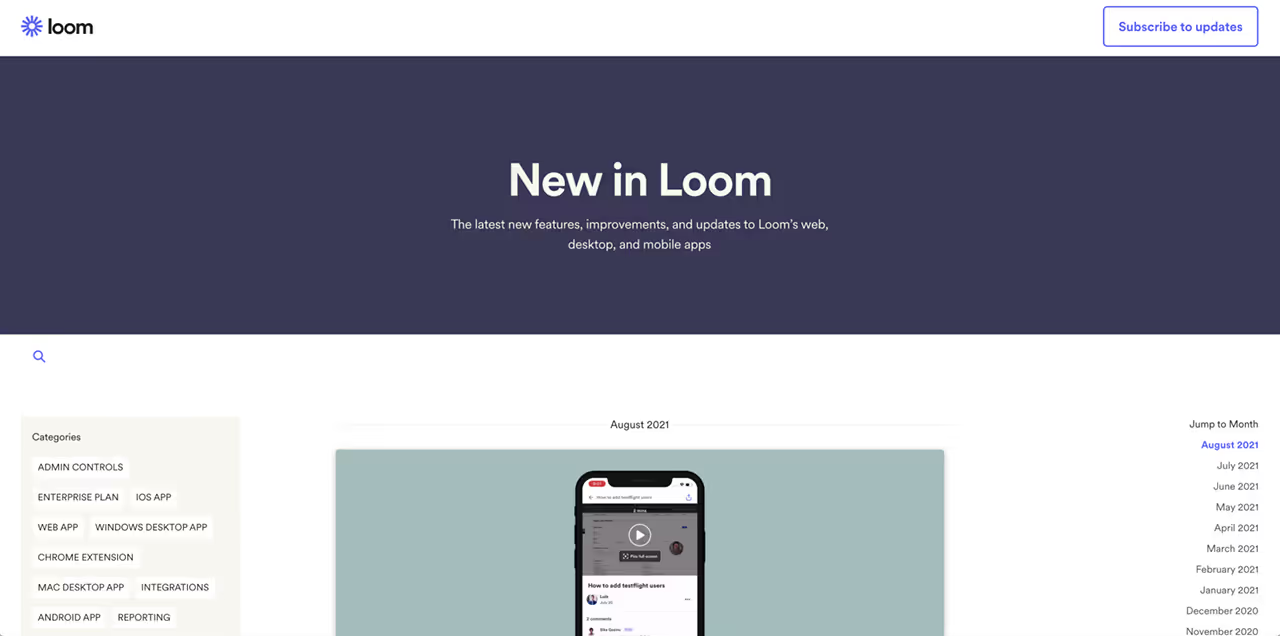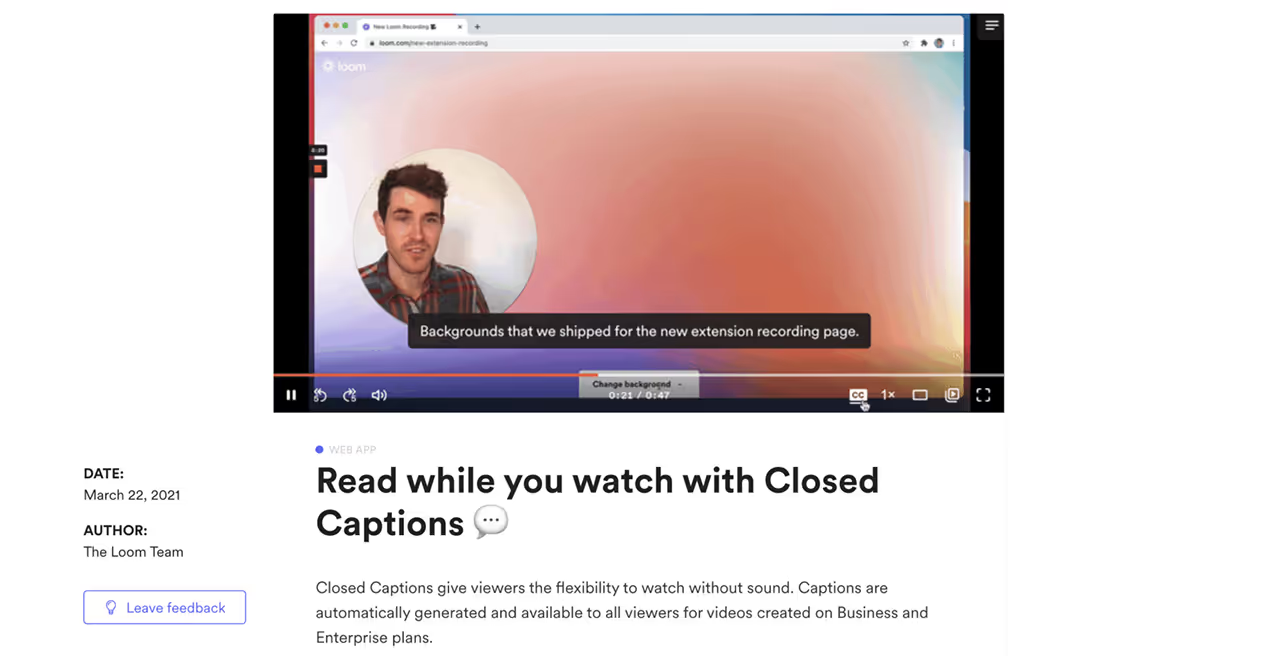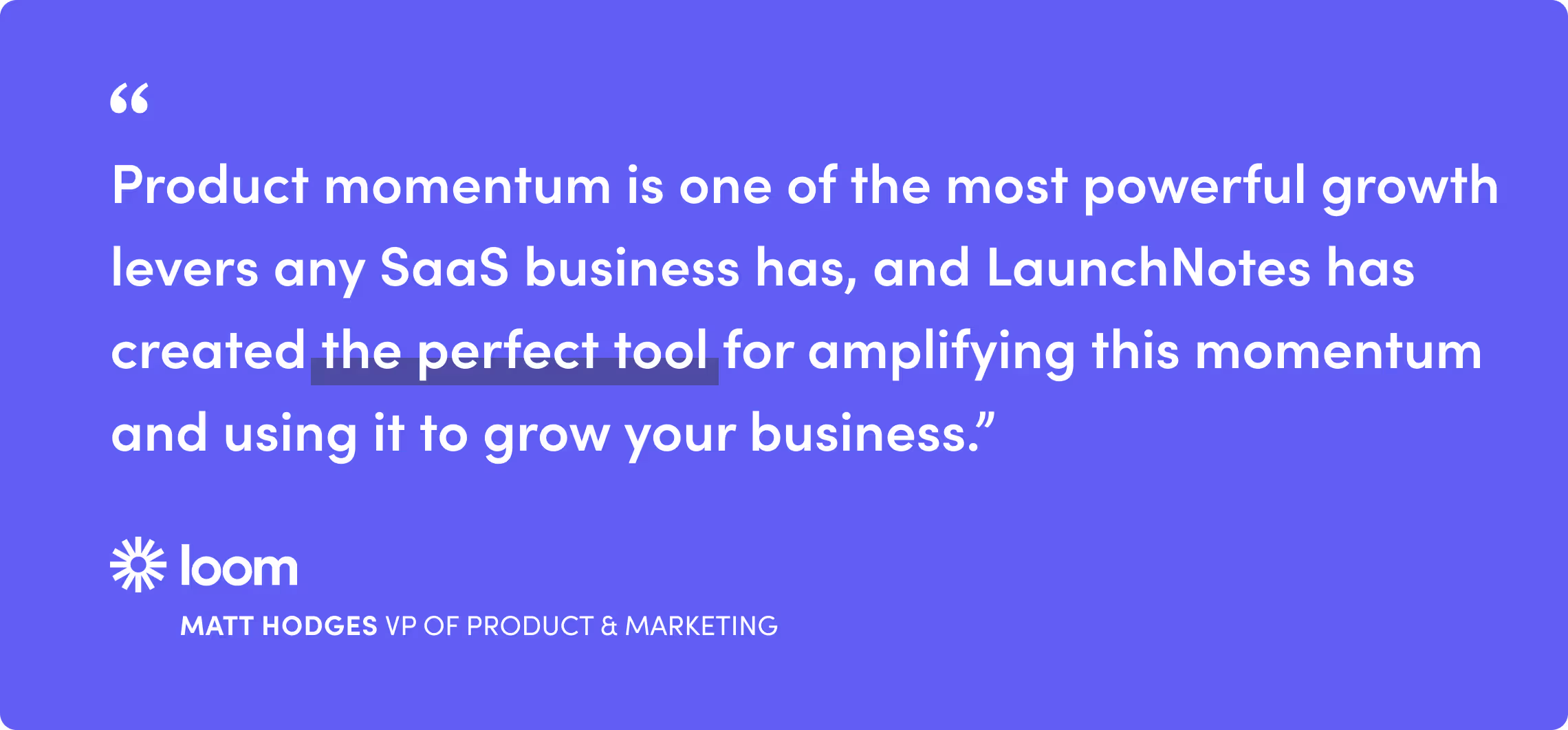How Loom Turns Product Momentum into a Key Growth Lever with LaunchNotes
Aligning Internal Teams and Enterprise Customers with a Multi-Product Portfolio
To say Loom has been on a growth tear would be an understatement. The company, which makes a work communication tool to instantly create and send shareable videos, raised almost $200M between 2019 and 2021. Propelled by explosive growth and fueled by a global shift to remote-first workplaces, seemingly overnight Loom matured from a promising startup to a household name in most businesses.

Not surprisingly, when Matt Hodges joined Loom as the VP of Product & Marketing in the Fall of 2019, he faced a number of competing priorities. He explains: “I was brought on to take Loom’s GTM efforts from zero to one. This included devising and executing a new product strategy, building a marketing team that would support this strategy, crafting the company’s positioning and messaging, overhauling our pricing and packaging… there was a lot going on!”
And at the top of this substantial to-do list, Matt knew he needed a way for his team to quickly get the word out about the new features and updates that Loom was regularly shipping. In his view, a SaaS company’s product momentum is one of its most effective GTM assets. “So much of early growth is about creating loyal fans that will amplify your presence in the market,” Hodges says. “Ensuring your product and marketing teams have an easy way to do this is one of the most important things a startup can do to set themselves up for success.”

Having tried a number of different point-solution changelog tools, and with previous experience building and managing a disappointing homegrown change management tool, Matt set out to find something more robust that would meet Loom’s needs. Today, with hundreds of successful announcements under their belt, today Loom is one of LaunchNotes’ most active users.
We had a chance to sit down with Matt to hear more about why he chose LaunchNotes, the benefits he and his team realized after adopting the product, and the most important things for Growth-stage SaaS businesses to be focused on in the early days.
Leveraging Loom’s rapid development cycles as a competitive advantage and growth engine
Hodges, a veteran of both Atlassian and Intercom, is no stranger to leading product and marketing organizations through rapid expansion. In fact, he says helping businesses scale is one of the things he loves most about his job. In his words: “The ability, and need, to move fast, make decisions quickly, and “ship to learn” is what I love most about working with growth-stage companies. You can learn so much in such a short span of time.”
But Hodges also shares that, in his experience, many companies don’t fully leverage the momentum of this explosive growth, and he sees this as a major missed opportunity: “Companies who hit that inflection point and begin growing like crazy are often so focused on keeping the train on the tracks that they forget to leverage this growth as a GTM tool and major competitive advantage,” Matt says. “Rapid growth is usually driven by strong product momentum, and strong product momentum wins new business,” he tells us.
So when Matt joined Loom in the Fall of 2019, not long after the company had closed their Series B, he wanted to ensure he and his team were ready to fully capitalize on the business’ growth curve. “Loom was updating their product at a rapid clip, and delivering a steady stream of value to users, which we needed to create loyal fans and inspire confidence in prospective and existing customers looking to more widely adopt the product,” he tells us. “So when LaunchNotes–a tool built specifically for communicating these improvements and showcasing this value–came on the market, I adopted it immediately.”

But harnessing Loom’s development velocity as a growth driver wasn’t the only reason Matt was eager to adopt LaunchNotes. He chose the tool over other potential solutions because he was equally as excited about the LaunchNotes’ development velocity and product vision: “When I discovered LaunchNotes it was clear the team behind the product was both knowledgeable and passionate about the problem they were solving. And when I saw how quickly they were shipping updates and improvements of their own, and their roadmap for where they were taking the product, I was immediately bought in.”
Avoiding the past mistake of building a homegrown product comms solution
Having led and partnered with various product and marketing teams for almost a decade, when Matt went looking for a solution to amplify Loom’s development velocity, he was committed to learning from past mistakes.
Chief among these lessons was developing a homegrown solution that required R&D resources to upkeep. As Matt explains, “From the very early days at Intercom–where I led marketing at the time–we believed strongly in keeping our customers (and the wider market) abreast of all the improvements we were making to our product. So we built a homegrown solution called Intercom Changes,” he tells us. “But the bigger we got, the more priorities there were, and the harder it became to invest dedicated R&D resources to maintain our public changes page.”
Hodges goes on to confirm one of the oldest rules in the book of scaling businesses: building rarely offers more benefit than buying in the long run. “At Intercom we invested in a solution that was not core to what we were building for our own customers, and it ultimately didn’t end well. Thankfully, now that out-of-the-box solutions like LaunchNotes exist, there’s no reason for any team to ever build a homegrown solution again,” he says.
Matt adds: “I’ve actually used three alternatives to LaunchNotes in past roles, and each excelled in one area or another. But LaunchNotes has developed the only purpose-built tool for communicating both product changes and public roadmaps. The ability to not only easily communicate product updates, but do so within the context of where the product is headed, differentiates the product from alternatives.”

Knowing building wasn’t an option, these were the criteria Hodges and his team had for a product change communication solution:
- “Keep our customer-base up-to-date with the improvements we were making to the Loom product without over-messaging them
- Provide a single place to which we could point people to see how the product was evolving over time, including the direction the product was headed to inspire confidence that Loom would continue improving
- Be a tool that could be 100% owned and managed by product and marketing, without any dependency on engineering”
“Until LaunchNotes, there was no one tool that could do all three of these things,” Hodges says. “Now I can’t see any reason why a modern product or marketing team would ever build or maintain a homegrown solution. It makes no sense.”
Adopting a tool that put product and marketing in the driver’s seat of product change comms
As someone whose career was largely shaped by his experience in product marketing, a role that sits squarely between the product and marketing orgs, it wasn’t surprising to see Matt's passion for ensuring those closest to the product strategy and roadmap had the necessary tools for properly communicating product change. In his words, “Prior to LaunchNotes, our product updates were a mix of sporadic blog posts and emails and in my experience these kinds of one-off activities don’t set up any GTM motion to be successful over the long run. LaunchNotes was the perfect solution to this problem.”

Beyond satisfying the three main criteria that Matt and his team had, he remarks, “LaunchNotes is one of the only tools I’ve used that requires no dependency on other teams to get going or use on a daily basis,” he says. “The product is painless to set up, and our team was getting value out of it on day one.”
Closing thoughts
In closing, we asked Matt two final questions:
- What would you tell other product and marketing leaders considering LaunchNotes?
“Just do it! Product momentum is one of the most powerful growth levers any SaaS business has, and LaunchNotes has created the perfect tool for amplifying this momentum and using it to grow your business. The risk is low. The potential payoff is high.”

How would you describe LaunchNotes in one word?
“Confidence-building.”
“...Wait, is that one word?... did I cheat…?”
“In any case, I would say LaunchNotes gives your current customers, and customers of tomorrow, the visibility and confidence they need to bet on your product.”


